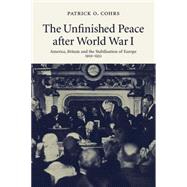
Note: Supplemental materials are not guaranteed with Rental or Used book purchases.
Purchase Benefits
What is included with this book?
| Acknowledgements | p. x |
| List of abbreviations | p. xii |
| A note on the footnotes and bibliography | p. xiv |
| Introduction | p. 1 |
| Prologue: The truncated peace of Versailles and its consequences, 1919-1923 | p. 20 |
| The wider challenges The legacy of the Great War and the era of imperialism | p. 25 |
| Wilson, Lloyd George and the quest for a 'peace to end all wars' | p. 30 |
| The ill-founded peace of 1919 | p. 46 |
| The escalation of Europe's post-Versailles crisis, 1920-1923 | p. 68 |
| The Anglo-American stabilisation of Europe, 1923-1924 | |
| Towards a Progressive transformation of European politics The reorientation of American stabilisation policy, 1921-1923 | p. 79 |
| Towards transatlantic co-operation and a new European order The reorientation of British stabilisation policy, 1922-1924 | p. 90 |
| The turning-point The Anglo-American intervention in the Ruhr crisis | p. 100 |
| From antagonism to accommodation The reorientation of French and German postwar policies, 1923-1924 | p. 116 |
| The two paths to the London conference The Dawes process and the recasting of European international politics | p. 129 |
| The first 'real' peace settlement after World War I The London agreement of 1924 and the consequences of the 'economic peace' | p. 154 |
| Europe's nascent Pax Anglo-Americana, 1924-1925 | |
| The dawning of a Progressive Pax Americana in Europe? | p. 187 |
| Towards the Locarno pact Britain's quest for a new European concert, 1924-1925 | p. 201 |
| Regression? US policy and the 'political insurance' of Europe's 'economic peace' | p. 220 |
| Beyond irreconcilable differences? New German and French approaches to European security | p. 227 |
| The path to Locarno - and its transatlantic dimension | p. 237 |
| The second 'real' peace settlement after World War I The Locarno conference and the emergence of a new European concert | p. 259 |
| The unfinished transatlantic peace order: the system of London and Locarno, 1926-1929 | |
| Sustaining stability, legitimating peaceful change The challenges of the latter 1920s | p. 287 |
| Progressive visions and limited commitments American stabilisation efforts in the era of London and Locarno | p. 296 |
| 'Reciprocity'? Britain as 'honest broker' in the Locarno system | p. 325 |
| The new European concert - and its limits | p. 345 |
| Thoiry - the failed quest for a 'final postwar agreement' | p. 378 |
| Towards peaceful change in eastern Europe? The crux of transforming Polish-German relations | p. 409 |
| Achievements and constraints The European security system of the latter 1920s | p. 417 |
| No 'new world order' The limits of the Kellogg-Briand pact | p. 448 |
| The initiation of the Young process The final bid to fortify the system of London and Locarno | p. 477 |
| The last 'grand bargain' after World War I The Hague settlement of 1929 and its aftermath | p. 531 |
| Epilogue: The disintegration of the unfinished transatlantic peace order, 1930-1932 - an inevitable demise? | p. 572 |
| Conclusion: The incipient transformation of international politics after World War I - learning processes and lessons | p. 603 |
| Map: Post-World War I Europe after the peace settlement of Versailles | p. 621 |
| Bibliography | p. 623 |
| Index | p. 651 |
| Table of Contents provided by Ingram. All Rights Reserved. |
The New copy of this book will include any supplemental materials advertised. Please check the title of the book to determine if it should include any access cards, study guides, lab manuals, CDs, etc.
The Used, Rental and eBook copies of this book are not guaranteed to include any supplemental materials. Typically, only the book itself is included. This is true even if the title states it includes any access cards, study guides, lab manuals, CDs, etc.